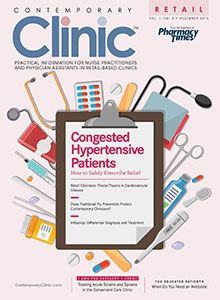Episodic Migraines Can Develop Into Chronic Migraines
The results of a recent study show that individuals who reported high efficacy of pharmacologic treatment of their episodic migraines had lower rates of developing chronic migraines.
The results of a recent study published inNeurologyshow that individuals who reported high efficacy of pharmacologic treatment of their episodic migraines had lower rates of developing chronic migraines.
In comparison, individuals who reported moderate to poor efficacy of their pharmacologic treatment had increased rates of developing chronic migraines. Additionally, individuals who reported they were still experiencing pain 2 hours after medication were 50% more likely to experience progression to chronic migraines the following year, compared with individuals who reported being pain-free at least half of the time within the same time period (4.4% vs 2.4% of subjects, respectively).
Similarly, only 1.9% of individuals who achieved maximum treatment efficacy had progression to chronic migraines—a significant difference compared with individuals who had moderate, poor, or very poor efficacy (2.7%, 4.4%, and 6.8%, respectively). None of the medication classes alone were associated with chronic migraine onset; however, triptans showed the most efficacy.
Although limited by self-reporting, these results seem to show a clear association between treatment efficacy for acute migraines and the development of chronic migraines. Effective control of acute migraines shows promise for reducing the risk of developing chronic migraines.

Knock Out Aches and Pains From Cold
October 30th 2019The symptoms associated with colds, most commonly congestion, coughing, sneezing, and sore throats, are the body's response when a virus exerts its effects on the immune system. Cold symptoms peak at about 1 to 2 days and last 7 to 10 days but can last up to 3 weeks.
COPD: Should a Clinician Treat or Refer?
October 27th 2019The Global Initiative for Chronic Obstructive Lung Disease (GOLD) defines the condition as follows: “COPD is a common, preventable, and treatable disease that is characterized by persistent respiratory symptoms and airflow limitation that is due to airway and/or alveolar abnormalities usually caused by significant exposure to noxious particles or gases.â€
Diabetic Ketoacidosis Is Preventable With Proper Treatment
October 24th 2019Cancer, diabetes, and heart disease account for a large portion of the $3.3 trillion annual US health care expenditures. In fact, 90% of these expenditures are due to chronic conditions. About 23 million people in the United States have diabetes, 7 million have undiagnosed diabetes, and 83 million have prediabetes.
What Are the Latest Influenza Vaccine Recommendations?
October 21st 2019Clinicians should recommend routine yearly influenza vaccinations for everyone 6 months or older who has no contraindications for the 2019-2020 influenza season starting at the end of October, according to the Advisory Committee on Immunization Practices.
What Is the Best Way to Treat Pharyngitis?
October 18th 2019There are many different causes of throat discomfort, but patients commonly associate a sore throat with an infection and may think that they need antibiotics. This unfortunately leads to unnecessary antibiotic prescribing when clinicians do not apply evidence-based practice.
